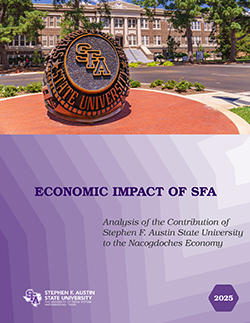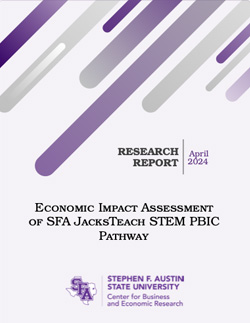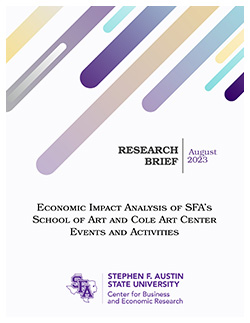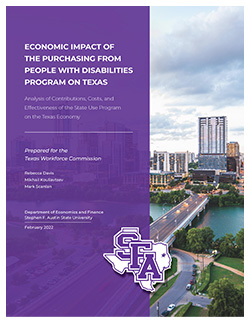What is an Economic Impact Study?
Local and state government agencies; nonprofits; small, medium and large businesses; civic groups; and SFA as a whole as well as individual departments and offices have requested various research and consulting projects from the Center for Business and Economic Research. Below are examples of economic impact analyses completed by CBER researchers.

Economic Impact of SFA
The Economic Contribution of SFA to the Nacogdoches Economy
SFA plays an important role in higher education. It also contributes to the economy of Nacogdoches County by being a major employer, attracting thousands of students and tens of thousands of visitors to the area, and engaging in substantial economic activity with local and regional businesses.
Using data from the 2022-23 academic year, we estimate the impact on the local economy of the university’s operations, the spending by students enrolled during the academic year as well as summer terms, employee spending, and the spending by out-of-town visitors on the region that would not take place if not for SFA.
The university accounts for over $348 million of local economic activity and supports 4,819 local jobs.

Economic Impact Assessment of SFA JacksTeach STEM PBIC Pathway
This report analyzes the impact a post-baccalaureate alternative certification program may have on increasing the number of highly trained STEM teachers in East Texas.
The proposed program is based on a model developed by UTeach, a nationally recognized STEM teacher preparation program. JacksTeach is a replication site of UTeach.

Economic Impact Analysis of SFA's School of Art and Cole Art Center Events and Activities
The analysis presented in this report focuses on the School of Art and Cole Art Center contributions to the local economy.

Economic Impact of the Purchasing From People With Disabilities Program on Texas
The report, requested by the Texas Workforce Commission, shows that the State Use Program benefited Texas in multiple ways, including adding approximately $300 million to the state’s gross domestic product and around 9,000 jobs each year for fiscal years 2019 and 2020.
 Axe ’Em, Jacks!
Axe ’Em, Jacks!


